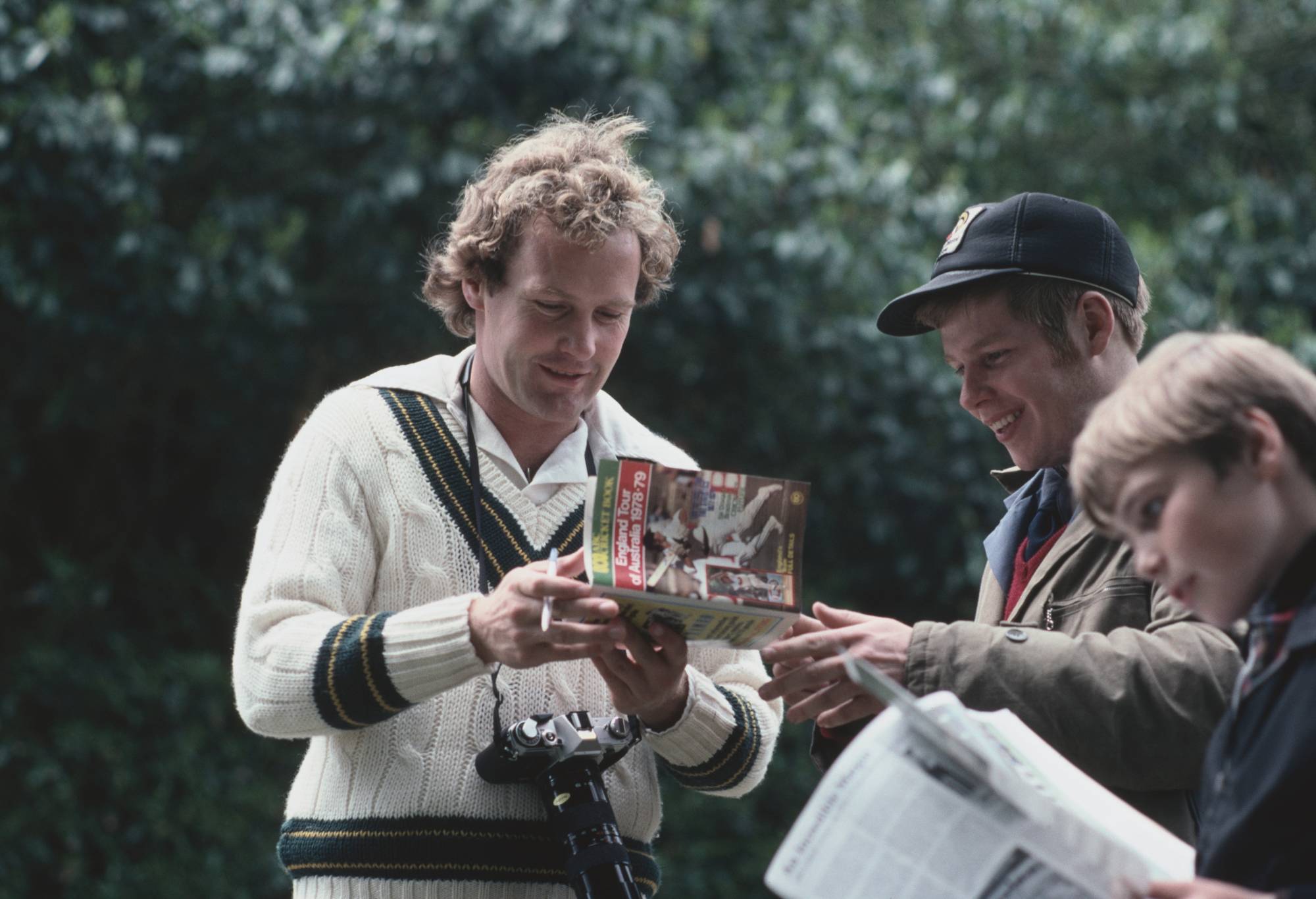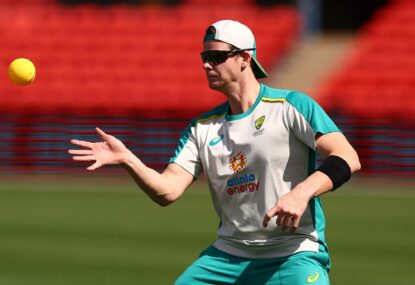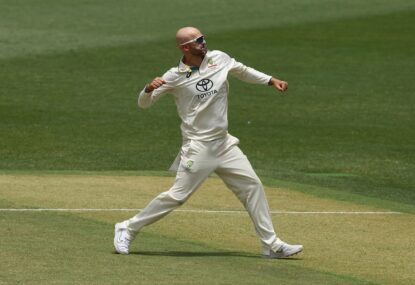Most Australian World Cup campaigns live on in the minds of fans.
The thrilling epic of 1975 (“Mano a Mano against the Windies!”), the disaster of 1983 (“we lost to who?!?”), the delightful surprise of 1987 (“we won what??”), the disappointment of 1992 (“damn Kiwi off spinning opening bowlers!”), the excitement of 1996 (“damn Sri Lankan opening batters!”), the blockbuster of 1999 (“I remember that over like it was yesterday…”), the smug certainty of 2003 (“Who needs Warnie!”) and 2007 (“did they ever find out if it was murder?”), the mediocrity of 2011 (“at least the Indians will be happy”), the smug certainty of 2015 (“take that in the first over, McCullum!”) the puffiness of 2019 (“yeah yeah Stokes whatever yeah yeah”).
The exception is 1979, aka the least famous World Cup of them all.
From an Australian point of view, that is, I can’t vouch for other countries. The West Indies presumably have good memories, having won it; maybe England, who made the final, which is probably the most famous match, due to Boycott and Brearley blocking and Collis King going the tonk.
But ask an Aussie about it and you’re most like to get an answer along the lines of “oh was there a World Cup on?” Even a die hard might be pressed to come up with something more than “didn’t we almost lose against Canada or something?”
So in the interests of pointlessness I thought I’d revisit this campaign.
It took place in June 1979, a weird time for Australian cricket, because we were getting out of the World Series Cricket divide. Kerry Packer won that war, and 1979-80 would be a reunited season again – but the compromise happened too late for the selection of the Australian squad. This meant we’d be taking our second tier side – a team that beat India 3-2, lost to the West Indies 3-1 and England 5-1.
There was some cause for optimism. Australia had managed to defeat England in a brief one day series by 2-1 (two games were washed out), and they’d won their last test against Pakistan. That victory had been under the new captain Kim Hughes who had only stepped into the job after Graham Yallop was injured. During the game Hughes had to leave the field and Andrew Hilditch, vice captain, took over for a few hours.
Out of interest the team that beat Pakistan was:
Kim Hughes
Rick Darling
Andrew Hilditch
Allan Border
Dav Whatmore
Jeff Moss
Trevor Laughlin
Rodney Hogg
Alan Hurst
Geoff Dymock
Kevin Wright
Bruce Yardley.
It was thought this team plus Yallop and maybe Peter Toohey, Gary Cosier (who’d impressed in those ODIs against England) and Wayne Clark, would form the World Cup squad. Jim Higgs had bowled well that summer but was thought a long shot due to his batting and fielding and the belief that leg spinners did poorly in England.
Anyway, Australia’s squad was decided on 6 April March by Phil Ridings, Sam Loxton and Neil Harvey. The team was:
Batters: Kim Hughes, Allan Border, Rick Darling, Andrew Hilditch, Jeff Moss, Graham Yallop, Dav Whatmore
All rounders: Gary Cosier, Trevor Laughlin.
Pace bowlers: Geoff Dymock, Rodney Hogg, Alan Hurst, Graeme Porter.
Wicketkeeper: Kevin Wright.
Team managed by David Richards, the secretary of the Victoria Cricket Association.
The announcement of team didn’t include an appointment of the captain and vice captain. But selectors for the tour were Hughes, Hilditch and Yallop.

Australian fast bowler Rodney Hogg signs autographs for fans in Arundel, Sussex, during the ICC Cricket World Cup, June 1979. (Photo by Adrian Murrell/Getty Images)
The biggest shock in the squad was Porter who had only played 13 first class matches although he had taken 5-53 against England for WA. “I’m stumped,” said Porter, “I don’t believe it. I hadn’t even given any thought to the World Cup.”
Wayne Clark and Phil Carlson were overlooked as were Peter Toohey and Grace Wood.
I would’ve taken Phil Carlson instead of Porter and of course John Inverarity should’ve been captain – he could’ve taken Moss or Whatmore’s spot and his off spinners would’ve been handy in a team without a specialist spinner.
On the spinning issue… Jim Higgs had done well over the summer but leg spinner was considered not very useful in England. There was Bruce Yardley, who could also bat. His form had tailed off. I would’ve taken him but there were issues with his action which meant Yardley never toured England. So Allan Border and Yallop had to be the spinners which was silly.
On 12 April the ABC announced that Kim Hughes was captain and Hilditch vice captain. Yallop said: “Now I am just going to put my head down and score as many runs as possible for Australia. The pressures associated with the captaincy are off me and I will work twice as hard on my batting to prove a few points to a few people.”
Hughes said: “Frank Parry told me when I was a 14 year old that I would captain Australia one day. Everyone laughed at him but now he has the smile. Our win over Pakistan has given me and the team great confidence.”
The situation got spicy when sections from Yallop’s ghosted account of the summer, Lambs to the Slaughter, were published in April.
These included many criticisms of Hogg. “He has no understand or sympathy at all about the lot of a fast bowler,” said Hogg. “Yallop was totally arrogant and non understanding throughout the series. And I am not the only member of the team that felt that.”
Hogg thought Yallop’s book was “the sort of situation that could easily create some dissension in the camp. It certainly doesn’t make it any easier for Kim Hughes… Kim Hughes is arrogant in a small way, but he is prepared to work things out with you.”
The book was published on May 27, the day the team was meant to fly out. If you haven’t read that book, I urge you to do it. It’s hilarious.
“I believe in myself and I believe in the team,” said Hughes. “I think we’re back into the winning habit as a result of victory over the Pakis [Hughes’ term] and the World Cup will really give us the chance to establish ourselves. We’ve got certain strengths and weaknesses but so have all the others and we’re aiming to win our section and then take things from there. We’re looking to Rodney Hogg and Alan Hurst to continue the form they showed last summer, with the backing of the accuracy of Geoff Dymock and I’m expecting big things from all rounder Allan Border [again, Hughes’ term]. Our batting came of age against Pakistan and we’ve now got confidence in ourselves as batsmen. We’re obviously the underdogs but we’re a young side with a lot of ability.”
The bookies offered odds of 20-1 for Australia winning which wasn’t flattering. “If the bookies want to quote us at that price, that’s fine,” said Hughes. “The boys are pretty keen to get a slice of the action”. He added ‘I”m objective enough to accept that the West Indies must be the favourites.”
(They were, at even money, with England second favourites at 5/2).
Practice Games
Australia were scheduled to play several warm up games. The first one, against Middlesex, was abandoned due to rain.
Australia then took on New Zealand at Arundel. They picked this XI: Darling, Hilditch, Border, Hughes, Yallop, Cosier, Laughlin, Wright, Dymock, Hogg, Hurst.
That wasn’t a bad team apart from the lack of a spin option. Australia scored 5-205 (Hilditch 77, Darling 60, Hughes 32), dismissing New Zealand for 52 (Hurst 3-14, Hogg 2-11, Dymock 2-9, Laughlin 2-7). “It was exactly the right build up for us at this stage,” said Hughes, who admitted that New Zealand were without four of their best players (Glenn Turner, Geoff Howarth, John Wright and Richard Hadlee, who were all playing county cricket).
The next warm up game went less well, against Kent, the County Champions. The county side – who included several WSC players, incidentally (Bob Woolmer, Alan Knott and Derek Underwood), scored 8-281 – Dymock got 2-24 but Hogg went for 1-72. Australia made 8-208 in response (Yallop 46, Cosier 59). Although Australia lost, Hughes said “we have a much better idea now of the strategy of the game. I think the game did us far more good than beating New Zealand easily.”
Australia then played Hampshire, bringing in Moss and Whatmore for Yallop and Cosier, and Porter for Dymock. Hampshire were 3-33 (Hogg 0-11 off eight overs) when the game was called off due to rain.
It wasn’t great preparation for the Cup but other teams had games washed out, too.
The World Cup Matches
Australia’s first game was against England, at Lords. They picked the same side as the Kent game. I do think it was their strongest side, out of the players they had in the squad.
Australia began well, and were 1-97 at one stage but when Hilditch was dismissed for 47 they collapsed and were 9-159 at the end – Geoff Boycott, of all people, got 2-15, the wickets being those of Hilditch and Hughes. There were four runs outs – Yallop, Cosier, Hogg and Laughlin. England got the runs for the loss of four wickets, Gooch making 53 and Brearley scoring 44 off 147 balls !!!
Richie Benaud wrote: “Australia’s cricket teams still manage to find new methods of throwing away matches. Yesterday’s appalling innovation was to have four run outs.” Colin Cowdrey wrote “by lunch Australia had given themselves the perfect springboard for setting up a winning total. Yet, sadly, the Australian debacle, mid afternoon, was quite unaccountable, such a contrast from the morning’s play.”
David Richards said the Australians were “too keyed up” to play at their best. “Everyone in the side realised they had to do well to answer all the criticism and to stake claims for the future. I believe they were a little overawed by the enormity of their task.”
“We played pretty well throughout the day, except for that one hour after lunch,” said Hughes. “We failed to take advantage of a good start, both by our batsmen and bowlers. We know we have a lot of learn. Unfortunately there has not been time to prepare properly for these matches. I realise now that we should have been here three weeks before the World Cup. I suppose when you look at the game we have to realise that we are not a good team by world standards.”
Australia’s next game was against Pakistan. Hughes said: “They’re a great batting side but I don’t think they’ll be able to apply to same bowling pressure as England can.”
Hogg missed out due to a bronchial infection and was replaced by Graeme Porter while Laughlin was dropped for Moss to give the batting some extra strength… although this weakened the bowling.
Hughes won the toss and sent in Pakistan. Alan Hurst went for 17 runs from his first two overs; in his first six overs he bowled five wides and four no balls. Porter bowled extremely well going for 1-20 off 12 overs, and Dymock was also frugal. But Cosier, Hurst, Yallop and Border all got tonked as Pakistan put on 286. Australia were all out for 197 (Hilditch 72, Yallop 23).
After the loss Hughes again blamed lack of match practice. “We were unable to put things together for the entire 60 overs,” said Hughes. ‘There were periods when we did put everything together, but in both matches there was a time when we let the game slip.”
Then he said one of the all time Kim Hughes lines.
“Really I think our team is much better suited to Test cricket than one day cricket.”
(For those who came in late this team had just lost 5-1 to England in Tests at home.)
This result basically meant England and Pakistan would go to the next round, while Australia missed out.
Australia’s third and final game was against Canada. Hogg was back in and Moss made way for Porter. Opening batter Glenroy Sealy, born in Barbados, hit Hogg for four consecutive boundaries in the first over of the match. (Hogg’s final figures were 0-26 off two overs.) But then Hurst took 5-21 and Porter and Cosier took two weeks each and Canada were dismissed for 105. Australia lost three wickets reaching the target
So we beat Canada at least.
“What is to become of Hogg?” wrote one journalist after this game. “Is he a cricketing comet, his glittering record breaking display now ended?” [Spoilers: he would never reach those 1978-79 heights again but would still have a terrific career, and become a superb ODI bowler.]
Another wrote, “It has been a troubled fortnight for Australia. Apart from the opening two hours at Lord’s against England and the splendid innings by Hilditch against Pakistan there has not much that has been good.”
A more sympathetic journalist felt “practically everything was against them [Australia] from the moment they left Sydney. They had only 12 days to prepare for that match with England, two of their four one day practice games were washed out and they couldn’t even get on turf wickets for a week. They came two months out of season to play a specialist game against people who make their living playing it every week. Of course the rain also interrupted the preparations of the other teams but most of the players have been involved in the English county championship since April… Australia’s inexperience of one day cricket was obvious.”
In July 1979 Hughes was named captain of the team to tour India. Laughlin, Cosier and Moss were excluded from this squad in favour of Yardley, Wood and Sleep. Then in 1979-80 the Packer players were available for selection.
Hughes, Border, Hogg and Yallop went on to play a bunch of other ODIs, including the 1983 World Cup. Border led Australia to victory at the 1987 World Cup and was in charge of the disappointing 1992 campaign.
The other members of the squad generally faded from view at an international level though some had their moments (eg Darling in ODIs in 1981-82, Dymock in 1979-80). I’m surprised Cosier, Porter and Laughlin especially didn’t have more of an ODI career. But then, that’s cricket. You can never pick how things are going to go. Although sometimes you can guess – and most guessed the 1979 World Cup squad would struggle and it did.






































































































